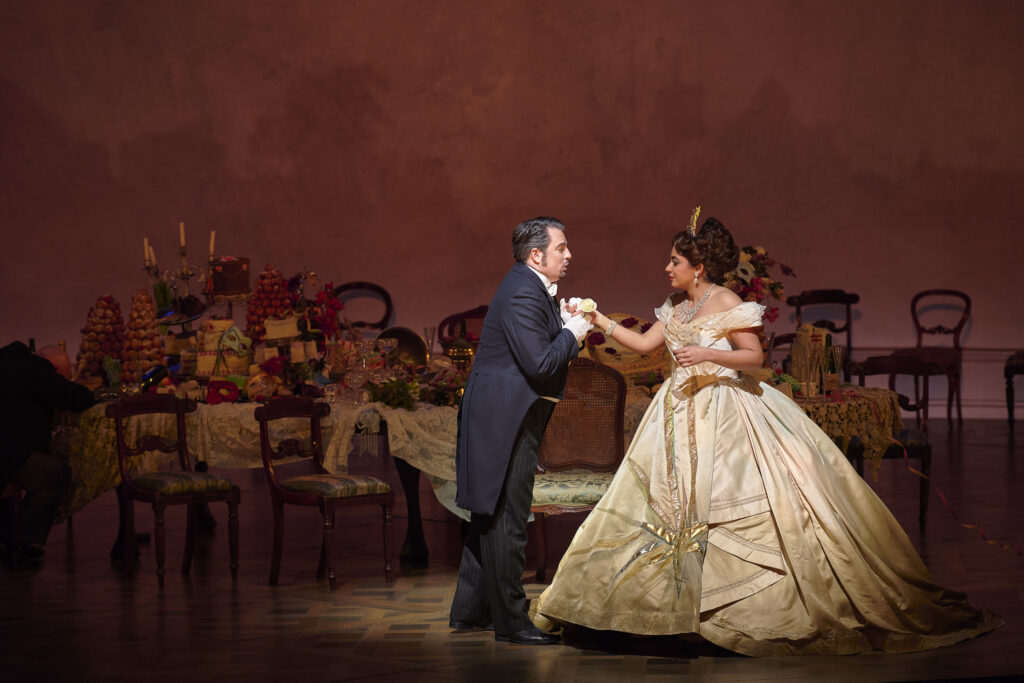Director Arin Arbus’ vibrant setting of Verdi’s classic masterpiece, currently on offer at the Four Seasons Centre, owes none of its success to reinvention. The antique frame of reference never cracks. The elegant patina never fades. Design and staging seldom stray beyond the bounds of the familiar. 19th century Italian grand opera rules. The music overwhelms. All is as it was once upon a time in the opera house.
On an intensely dramatic opening night capped by a sudden medical emergency in the audience (non-critical, General Manager Perryn Leech assured us) that abruptly paused the final act, the Canadian Opera Company unveiled a fine, unapologetic revival of its 2015 La Traviata last Saturday, the first in-person programming from the battered but still formidable mainstream producer in over two years.
The long wait for the COC’s re-emergence as an active force in live theatre has been well rewarded. The marked timelessness of this clear-eyed, unfailingly open-hearted production is immensely welcome. Arbus positively revels in the lush periodicity. Art design and direction occupy more than their fair share of the spotlight here.
The impossibly billowy gowns of the fashionable bourgeoisie sail across a fundamentally unadorned stage in an extravagant show of shared identity and, for at least one stylish young woman, alienation and confinement. Sempre libera (“Forever free”), sings Violetta, love for hire, but her declaration of freedom has as much to do with self-directed reassurance as spirited rebellion given her financial dependence on a legion of fickle, interchangeable frock-coated admirers. Or so it feels as she dresses for conquest at curtain rise. Povera donna, sola,/abbandonata in questo popoloso deserto/che appellano Parigi. (“A poor, lonely woman/abandoned in this teeming desert/they call Paris!”)
Silk and satin. Shadows and chandeliers. Party scenes are a champagne-fuelled battleground. Guests are as compulsive as they are raucous, feeding on the Parisian demi-monde, the latter conspicuous outliers, all overdone mascara and extravagant costumes. Masquerades are always in style, elaborate exercises in role-playing. Bulls and matadors, dancers and fortune tellers are particularly favoured, a swirl of big shirts and tight knee breeches, flouncy skirts and rampaging horned mannequins, skeletal and monstrous and calculated to unsettle.
Costume designer Cait O’Connor and lighting designer Marcus Doshi work wonders embedding narrative in craft.
Verdi was an exceedingly moral man, a liberal idealist plagued by the hypocrisy and chauvinism of mid-nineteenth Italian society. His life partner, renowned soprano Giuseppina Strepponi with whom he had a deep and abiding live-in relationship for over 40 years following the sudden tragic death of the his wife and two children, provoked no end of wholesale gossip. Dumas’ stage work unquestionably provided the composer with the opportunity to strike a very public blow against the tide of self-righteous judgement he had personally experienced.
Set in Paris during the Second Empire, La Traviata, for all its societal acuity, is ultimately no mere tract, however. The intensity of the drama, the deep, profoundly emotional resonance of Verdi’s towering score utterly overwhelm.
Story-telling in La Traviata — libretto by Francesco Maria Piave, after Alexandre Dumas fils’ La dame aux camélias — hinges, in large measure, on sharp, demonstrative characterization. Arbus and cast, strong singer-actors all, treat the tale of the delicate, ailing courtesan who sacrifices health and happiness for the sake of genuine love with great insight and finesse.
Appearing in the title role, Cairo-born New Zealand soprano Amina Edris presents us with a strikingly youthful Violetta, guileless and impulsive bordering on innocence, paradoxical in light of the character’s revealed worldliness. Life is complicated. That she should find love and devotion in the person of Alfredo — awkward Provençal country boy stunned by the razzle-dazzle of the City of Lights as embodied by tenor Matthew Polenzani — is rendered touchingly convincing by way of any number of masterfully discrete gestures of embarrassment on Polenzani’s part when the two centres of good first meet.
Tapping a similar vein of credibility, baritone Simone Piazzola fashions an initially violent, supremely sanctimonious Père Germont, his eventual shame and regret for bullying both son and Violetta made all the more profound by the forcefulness of his earlier abuse. Di più non lacerami,/Troppo rimorso l’alma mi divora (“Say no more, don’t torture me/Too much remorse seizes my soul”). Violetta’s death embraces him in a circle of acceptance and all-encompassing humanity.
Seen from a musical vantage point, La Traviata effectively leaps from operas past to those of the future, bel canto to Romanticism. The once distinctive formula that determined the course of virtually every Italian opera pre-Verdi — expository recit, languid cavatina, boisterous cabaletta — is still present to a degree but in La Traviata arias and ensembles are treated with far greater flexibility. Less of the expected. More of the spontaneous and impassioned.
Every soprano who undertakes Violetta is essentially triple-cast as three different singers — a coloratura, a lyric and a spinto/dramatic specialist often called on to perform together in the same scene. Confronted by a series of daunting Act I hurdles, introduced by a series of sensational runs during Alfredo’s Un di felice (“One day, happy and airy”), climaxing with the double showstoppers, Ah, fors’è lui (“Ah, perhaps he is the one”) and Sempre libera, Edris soars to the challenge, flying to the finish line with high notes to spare. A voice of considerable strength and agility.
Polenzani’s Alfredo is no less impressive, excitable and intense. Gifted with a ringing top and warm middle voice, Polenzani thrills with an electrifying De’ miei bollenti spiriti (‘The violent fire of my youthful spirits”), a lover in love with love.
Appearing as a particularly stern Giorgio Germont, Piazzola gives a masterclass in the overbearing father figure, imperious and stentorian. Nostalgia is his only refuge. Di Provenza il mar (“The sea and soil of Provence”) is touchingly sung.
Comprimari roles are all marvellously well-inhabited. Soprano Jamie Groote is a flighty Flora. Baritone Gregory Dahl is the philandering Baron Douphol. Mezzo-soprano Midori Marsh is a deeply sympathetic Annina. Bass-baritone Vartan Gabrielian appears as helpless Dr. Grenvil. Stephen Bell delights as Violetta’s snooty servant, Giuseppe.
The Canadian Opera Company Chorus, Sandra Horst chorus master, is quite simply glorious, assuming the collective role of La Traviata’s frenzied, dissolute, mob of party-going hangers-on. The Canadian Opera Company Orchestra, stirringly conducted by music director Johannes Debus, floods the FSC with an abundance of spectacular energy and colour.
An evening to be treasured. And long and loudly applauded.


